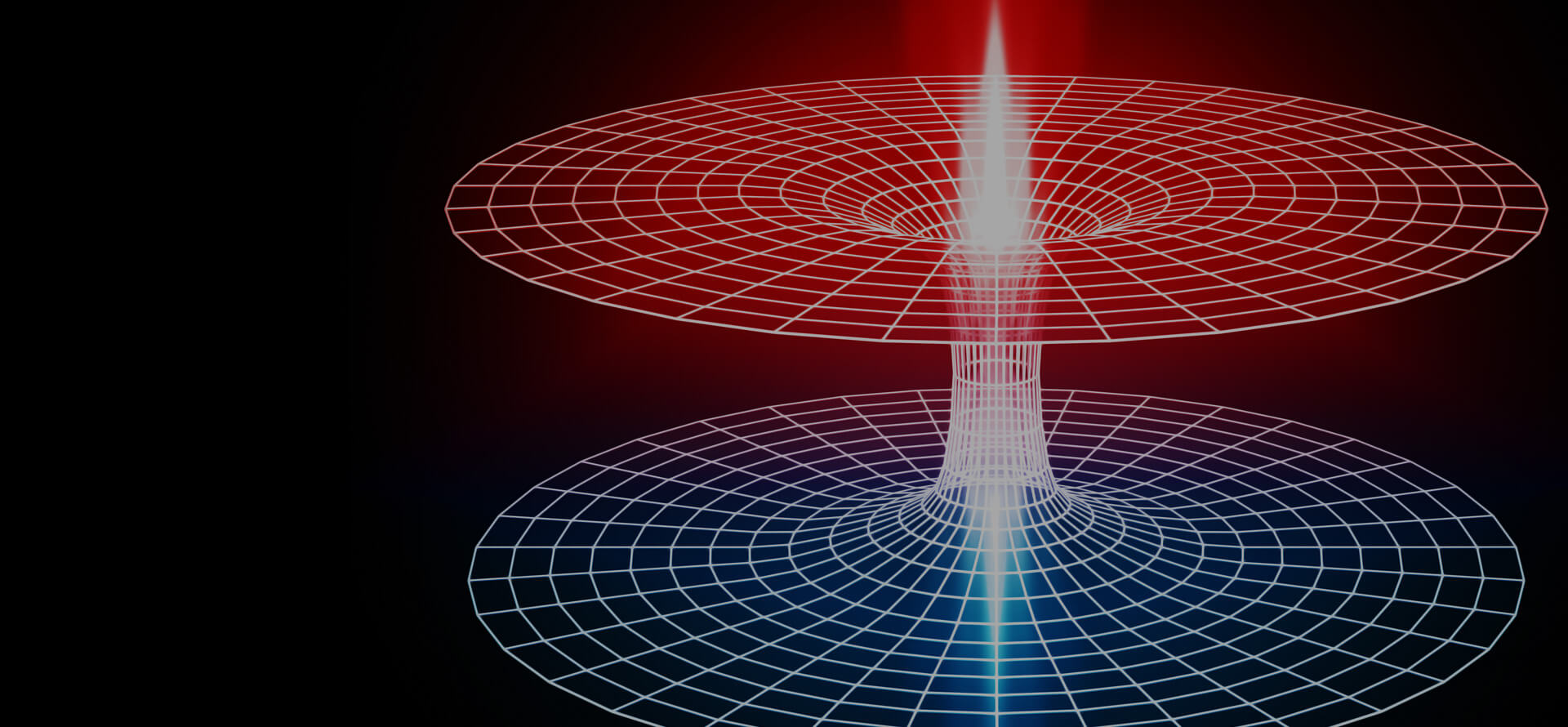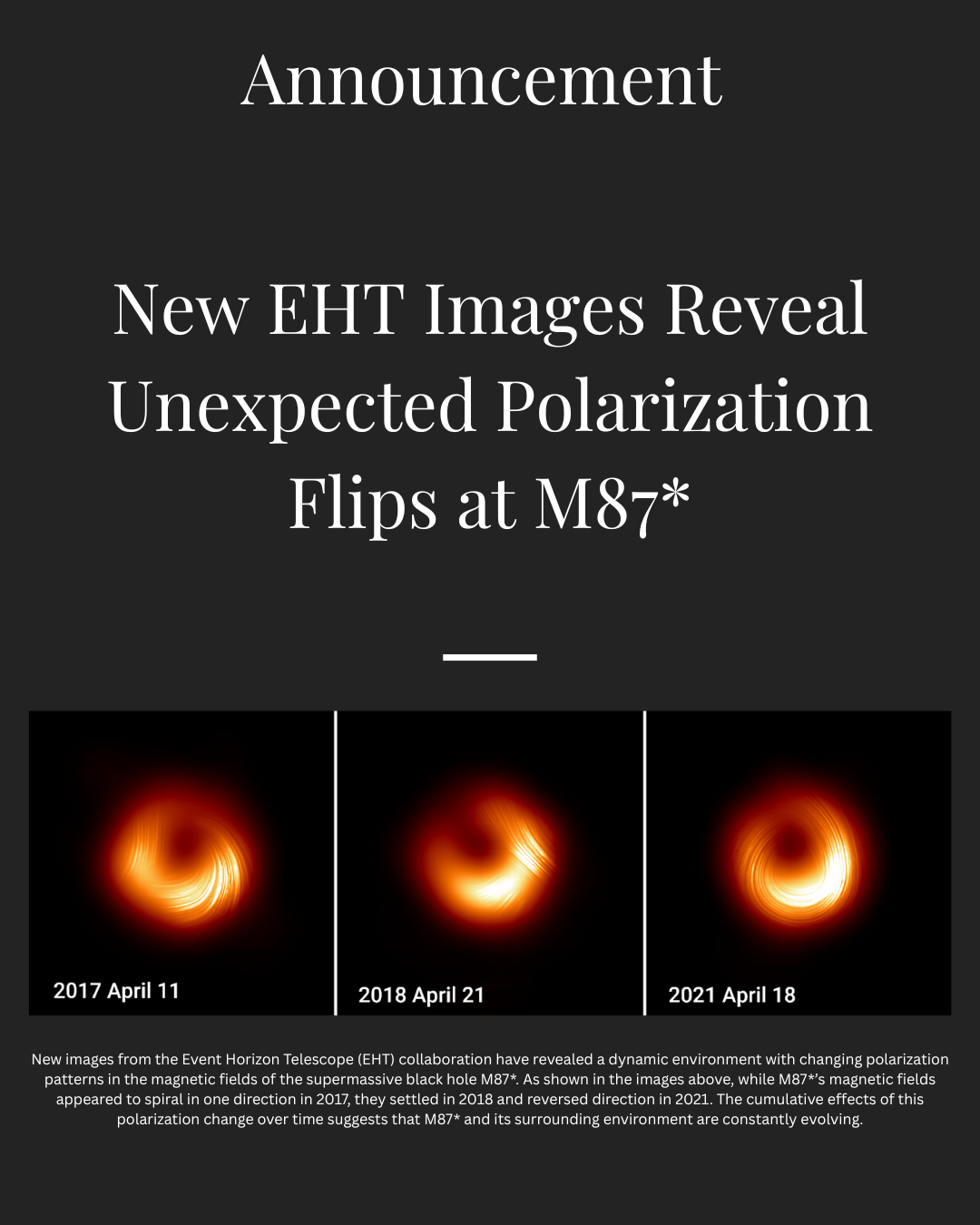
Paper
Press Release
Multi-year Event Horizon Telescope observations capture evolving polarization patterns in
supermassive black hole and see emissions in 230 GHz near the base of its jet
The Event Horizon Telescope (EHT) collaboration has unveiled new, detailed images of the
supermassive black hole at the center of the galaxy M87— known as M87— revealing a dynamic environment with changing polarization patterns near the black hole. Additionally, the scientists found the first signatures of the extended jet emission near the jet base, which connects to the ring around M87, in EHT data. These new observations, published today Astronomy & Astrophysics are providing new insight into how matter and energy behave in the extreme environments surrounding black holes. Scientists from the Center for Astrophysics | Harvard & Smithsonian are helping lead the international effort to unlock the secrets of M87* and its flipping polarization.
Located about 55 million light-years away from Earth, M87 harbors a supermassive black hole
more than six billion times the mass of the Sun. The EHT, a global network of radio telescopes
acting as an Earth-sized observatory, first captured the iconic image of M87’s black hole
shadow in 2019. Now, by comparing observations from 2017, 2018, and 2021, scientists have
taken the next step towards uncovering how the magnetic fields near the black hole change
over time.
“What’s remarkable is that while the ring size has remained consistent over the
years—confirming the black hole’s shadow predicted by Einstein’s theory—the polarization
pattern changes significantly,” said Paul Tiede, an astronomer at the Center for Astrophysics |
Harvard & Smithsonian, and a co-lead of the new study. “This tells us that the magnetized
plasma swirling near the event horizon is far from static; it’s dynamic and complex, pushing our
theoretical models to the limit.”
“Year after year, we improve the EHT – with additional telescopes and upgraded
instrumentation, new ideas for scientific explorations, and novel algorithms to get more out of
the data,” added co-lead Michael Janssen, an assistant professor at the Radboud University
Nijmegen and member of the EHT science board. “For this study, all these factors nicely
conspired into new scientific results and new questions, which will certainly keep us busy for
many more years.”
Between 2017 and 2021, the polarization pattern flipped direction. In 2017, the magnetic fields
appeared to spiral one way; by 2018, they settled; and in 2021, they reversed, spiraling the
opposite direction. Some of these apparent changes in the polarization’s rotational direction
may be influenced by a combination of internal magnetic structure and external effects, such as
a Faraday screen. The cumulative effects of how this polarization changes over time suggests an
evolving, turbulent environment where magnetic fields play a vital role in governing how
matter falls into the black hole and how energy is launched outward.
“The fact that the polarization pattern flipped direction from 2017 to 2021 was totally
unexpected,” Jongho Park, an astronomer at Kyunghee University and a collaborator on the
project. “It challenges our models and shows there’s much we still don’t understand near the
event horizon.”
Crucially, the 2021 EHT observations included two new telescopes—Kitt Peak in Arizona and
NOEMA in France—which enhanced the array’s sensitivity and image clarity. This allowed
scientists to constrain, for the first time with the EHT, the emission direction of the base of
M87’s relativistic jet—a narrow beam of energetic particles blasting out from the black hole at
nearly the speed of light. Upgrades at the Greenland Telescope and James Clerk Maxwell
Telescope have further improved the data quality in 2021.
“The improved calibration has led to a remarkable boost in data quality and array performance,
with new short baselines— between NOEMA and the IRAM 30m telescopes, and between Kitt
Peak and SMT, providing the first constraints on the faint jet base emission,” said Sebastiano
von Fellenberg, a postdoctoral fellow at the University of Toronto’s Canadian Institute for
Theoretical Astrophysics (CITA), and postdoctoral researcher at the Max Planck Institute for
Radio Astronomy (MPIfR) who focused on calibration for the project. “This leap in sensitivity
also enhances our ability to detect subtle polarization signals.”
“We built confidence in our results by thoroughly validating our analysis pipeline. Using a range
of synthetic data tests, we ensured our algorithms could reliably track changes in both the
polarization and the black hole shadow of M87,” said Erandi Chavez, an astronomy graduate student at Harvard University and project collaborator. “These careful checks give us confidence that the shifts we see in M87’s polarization over the years are genuine, not artifacts of our methods.”
Jets like M87’s play a crucial role in galaxy evolution by regulating star formation and
distributing energy on vast scales. Emitting across the electromagnetic spectrum—including
gamma rays and neutrinos—M87’s powerful jet provides a unique laboratory to study how these cosmic phenomena form and are launched. This new detection offers a vital piece of the
puzzle.
“These results show how the EHT is evolving into a fully fledged scientific observatory, capable
not only of delivering unprecedented images, but of building a progressive and coherent
understanding of black hole physics,” said Mariafelicia De Laurentis, a professor of astronomy
at the University of Naples Federico II and EHT project scientist. “Each new campaign expands
our horizon, from the dynamics of plasma and magnetic fields to the role of black holes in
cosmic evolution. It is a concrete demonstration of the extraordinary scientific potential of this
instrument.”
As the Event Horizon Telescope collaboration continues to expand its observational capabilities,
these new results illuminate the dynamic environment surrounding M87* and deepen
scientists’ understanding of black hole physics.
Media Contacts:
Amy C. Oliver, FRAS
Public Affairs Officer
Center for Astrophysics | Harvard & Smithsonian
amy.oliver@cfa.harvard.edu
+1 520-879-4406 (office)
+1 520-686-8712 (mobile)
Science Contacts:
Paul Tiede
Center for Astrophysics | Harvard & Smithsonian
paul.tiede@cfa.harvard.edu
Michael Janssen
Radboud University
michael.janssen@ru.nl
Sebastiano von Fellenberg
Postdoctoral Researcher
Max Planck Institute for Radio Astronomy (MPIfR)
Humboldt Feodor Lynen Fellow
Canadian Institute for Theoretical Astrophysics (CITA)
sfellenberg@mpifr-bonn.mpg.de
Jongho Park
Kyung Hee University
jparkastro@khu.ac.kr
Mariafelicia De Laurentis
University of Naples
mariafelicia.delaurentis@unina.it



